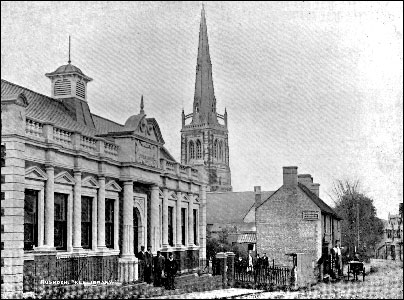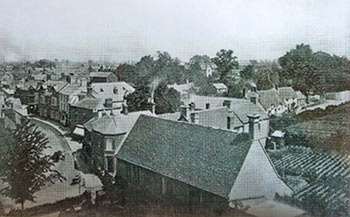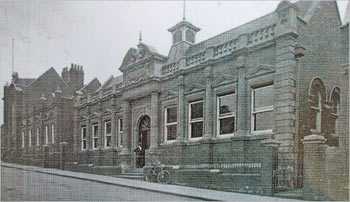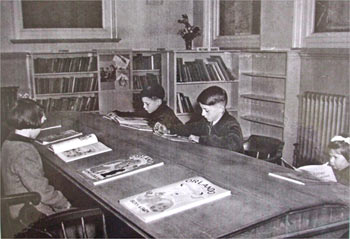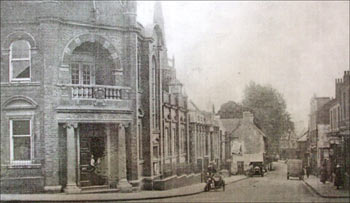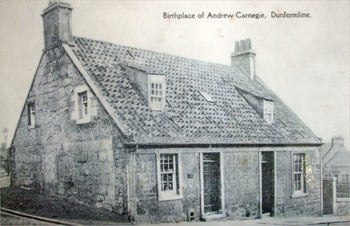|
|||||||||||||||||||||||||||||||||||||||||||||||||||||||||||||||||||||||||||||||||||||||||||||||||||||||
| Article based on "Notes Towards a History of Rushden Public Library 1902 - 1974 by R.L.Armsby |
|||||||||||||||||||||||||||||||||||||||||||||||||||||||||||||||||||||||||||||||||||||||||||||||||||||||
|
A History of Rushden Library
|
|||||||||||||||||||||||||||||||||||||||||||||||||||||||||||||||||||||||||||||||||||||||||||||||||||||||
|
|||||||||||||||||||||||||||||||||||||||||||||||||||||||||||||||||||||||||||||||||||||||||||||||||||||||
|
The Beginning of the Library
It is thanks to Councillor J. Claridge that Rushden had a Public or “Free” Library for it was he who wrote to the Scottish American millionaire Andrew Carnegie and secured from him the offer of £2,000 with which “to provide a Free Public Library building on condition that the Public Libraries Act of 1892 be adopted and a maximum rate of 1d in the £ be levied, and that a suitable site was provided, the cost of which was not to be a burden on the rates." Rushden Urban District Council met on 15 July 1902 to consider the offer and accepted it unanimously. A committee was appointed consisting of Councillor George Denton (Chairman of the Council), with Councillors J. Claridge, T. Swindall, F. Knight, and W.E.Wilkins who were to solicit subscriptions towards the cost of the site. The Public Libraries Act was adopted on 27 August, to come into effect on 1 November 1902.
During 1903 eight possible sites were considered by the Sites Committee and two Town Meetings before an agreement was reached and the Council’s Surveyor, Mr. W.B. Madin, was instructed “to prepare for and superintend the construction of the new Library building.” The Library was opened at 3pm on Saturday 25 November 1905 by the Marquis of Northampton, Mr Carnegie having declined the honour as he was in America on that date. Click here to read an account of the opening ceremony.
This jovial spirit was not to last, however. In December 1905 the Committee of Public Safety brought to the Council a petition signed by 30 people asking that the Betting News be removed from the papers stocked in the Library. The Council appointed a Committee for the Management and Control of the Free Library and referred the matter to it.
Book Stock Records about the early years of the Library are incomplete and in particular it is difficult to establish the number of books in stock as the reports merely quote the numbers of books added each year, but with no reference to the initial number of books provided. For a long time most of the books added were adult fiction and only a very small number of adult non-fiction being bought. Until 1919, the Library’s budget was restricted to the product of the 1d rate and like many other libraries in the country, had to rely heavily on donations. In the year 1917–18, 29 juvenile books were added to the stock, and 218 adult, of which only 6 were non-fiction, and 5 of these had been presented by members of the public. In 1923–24 only 2 adult non-fiction books were added. Eventually, in 1929 the Committee decided to join a scheme of inter-library co-operation – “the free interchange of books, excluding fiction, between the various libraries in the County ........the County Library to act as the clearing house.” While this was still not a perfect solution, it was a vital factor in helping to meet the needs of students and other readers with specialist needs. In the mid 1930s Miss Marian Perkins was appointed to the Library, first as an assistant, later as Librarian in succession to the first Librarian, Miss E. Mantle. Basic office equipment was added to the Library, including a typewriter which facilitated the production of an annual classified list of new non-fiction, leading in turn to a large increase in non-fiction issues. Over the next 10 years, the Librarian acquired two assistants who could attend to the routine issuing of books, allowing her to classify the existing non-fiction books in the Library and to compile an author catalogue of both fiction and non-fiction books. Four “Book Talks” were also given for the first time. A major landmark was the opening of a Junior Library Department in April 1943. This was remarkable progress for wartime. Evacuees posed a major problem for a Library which started the war with barely 5,000 books, but more children’s books were procured from Walthamstow and Wellingborough Libraries, and additional staff appointed. In the decade 1939–1940 to 1949-1950, the bookstock nearly trebled and book issues went up by nearly 60,000, from 74,944 to 134,660, a figure not to be equalled for another ten years. In 1938 Rushden Urban District Council became a Corporate member of the Library Association which allowed the Library to obtain a licence under the Net Books Agreement with the Publisher’s Association, thereby securing a discount on book purchases. It also began to exercise its right to send a representative to the Library Association Annual Conference and various regional meetings. Within its first 50 years of life, three problems were emerging which were to last as long as the Library itself. These were: insufficiency of shelf space for all the books, delay or non-return of books borrowed and theft or mutilation of papers in the Magazine Room. Staffing Miss Perkins left in 1950 and the following seven years saw three Librarians in succession being appointed. This coincided with a difficulty in recruiting and retaining suitable assistants which had an adverse affect on the services provided by the Library.
In March 1950 Mr C. Ray, A.L.A., was appointed Librarian. He was keen to modernize the Library building and make it more efficient by re-organising the interior space so as to facilitate the development of the various departments: Adult Lending, Reference (with Local Collection), Magazine Room and Junior Library. A plan to extend the Library by building an upper storey was drawn up but the scheme was then shelved, revived again in 1966 and 1967 but finally abandoned on account of financial constraints. Mr Ray also concerned himself with the selection of Reference Books and Periodicals, and is remembered for his topical book displays. Mr James R. English, A.L.A. (1957–62) was succeeded as Librarian by Miss R.L.Armsby, B.A. (Hons), F.L.A. (1962–74) and their terms of office, covering the last eighteen years of Rushden Library’s independent existence, may be considered together as its last phase. Both had to contend with the same difficulties and both suffered from the same frustrations. Internally it was a matter of the continually expanding service, especially the bookstock, versus the non-expanding four walls of the building. The following table illustrates the problem:
In 1960 Mr English reported shelves “grossly overcrowded” and volumes of reserve stock and books awaiting repair having to be kept inaccessibly in cartons in the Staff Work Room. Improvements were made by re-organising space and providing more shelves, but this relief was only temporary. Worse was to follow with books having to be crated up and stored off the premises. Only a big increase in issues made it possible to accommodate the increase in bookstock, and when issues began to fall off, firstly it was thought because of the opening of a very attractive Branch Library at Higham Ferrers but later recognised to be in line with national trends, there was again cause for grave concern as the books requiring shelf space began to pile up again.
The process of withdrawing older books to make room for the new was time consuming if agreed procedures were to be followed and the books, before being discarded, were offered first to libraries specialising in accordance with the National Joint Coverage Scheme and the Joint Fiction Reserve, and second through the British National Book Centre. It has been a matter of pride in Rushden that this should be done ever since 1938 when, after consultation with the East Midlands Regional Library Bureau, Rushden was asked not to discard 26 books as they were “unique in the area.” Since then many hundreds of books have been passed through these channels to libraries at home and abroad where they were most needed. Management of the Library Following the Roberts Report of 1955 and the Library Association initiative calling for small Authorities to relinquish their powers to the County Libraries, or to operate jointly with other authorities, the smaller public libraries formed themselves into The Smaller Public Libraries Group for mutual self defence against all threats to their independence. Mr English, on his appointment in 1957, lost no time in submitting to his Committee a summary of the recommendations of the Smaller Public Libraries Group and was asked to provide a supplementary “detailed analysis and assessment of the services provided at Rushden.” He did this at the next Committee meeting, and was thanked for the “information furnished.” The matter was then allowed to drop. In her turn, Miss Armsby brought to the notice of the Authority not only the criteria of efficiency of successive Ministers and others, especially those of the Government Working Party, but also comparative figures for Rushden such as her predecessor had been asked to furnish. The Working Party drew up standards for book provision, for staffing and for buildings. The Smaller Public Libraries Group too put forward standards of their own which were slightly lower than those of the Working Party but which they hoped would secure acceptance from the Government. Improvements all over the country resulted from Library Authorities trying to reach these standards but Rushden singled out only one, that for book provision, and increased its bookfund to approximately the sum called for in the standards. The Librarian had urged that all three – book provision, staffing and buildings – were interdependent, and experience was to show that it was not practicable to increase so considerably the numbers of books bought without increasing the space to put them or the staff to handle them. The result was confusion and chaos behind the scenes and an ultimate need to reduce book intake till it should balance with book withdrawals. The Local Government Act of 1972 meant an end to independence for Rushden Library, and at the invitation of the County Librarian, Rushden came together with the other independent libraries in Northamptonshire to form a group of “Northamptonshire Chief Librarians.” In this group they tried to plan for a smooth and orderly transition from the old to the new order and to work out together in detail “the shape of things to come.” Northampton Borough, Kettering and Wellingborough were each to become the head of their region of the county, but Rushden could not on account of the inadequacy of the 1905 building. After all, the Carnegie Library given to the town in 1905 had been built to serve a population of little more than 12,000, not the population of nearly 22,000 the town had grown to by 1972. So Rushden Public Library as an independent entity died but continued as one of the new “Northamptonshire Libraries.” Postscript In 1974 responsibility for libraries became a County function and Rushden Library became part of Northamptonshire Libraries. Neil Byron was appointed Librarian-in-Charge and the library was part of the Eastern District under Michael Davison who was based at Higham Ferrers library. Later, Michael Davison became District Librarian for Wellingborough and East Northants, retaining responsibility Rushden, and, following his untimely death in 1989, he was succeeded by Nick Matthews. In 1991 a reorganisation of Northamptonshire Libraries and Information Service included the introduction of Area Teams of librarians with responsibility for managing an area. Rushden was part of the Higham Ferrers Area, with Derrick Bond as Principal Librarian and Tina Hackett as Library Supervisor at Rushden. In 1995, by which time Rushden was part of the East Area under Julie Moreland (Principal Librarian), a major refurbishment of the library took place. In partnership with East Northamptonshire District Council backroom functions of the library were transferred to the neighbouring council building and a magnificent atrium was built providing both buildings with disabled access for the first time and allowing the library to expand considerably. With its sensitive refurbishment in 1995 the best features of the old library were retained but the building was made much more open than previously. In 1996 Tina Hackett retired and was replaced by the Wellingborough Library supervisor, Dominica Jones. She remained supervisor of Rushden Library under Principal Librarians Ingrid Mercer, Janet Sonpal and Hilary Ward until her retirement in 2008. In 2005 when it celebrated its centenary, Rushden Library remained one of the county’s busiest libraries, welcoming over 2,500 visitors per week. The book stock was complemented by a computer suite which was installed in 2003, and collections of videos, DVDs and CDs. Whilst maintaining an excellent range of books and information, the computers give electronic information which would fill the library many times over with reference books. Children continue to be well served and the library serves the local community by providing a venue for a monthly Reading Group and a Writers' Cafe. Material is available to those with an interest in Local History, including microfilms and old newspapers. A home service is available for residents who are disabled. In 2008 the library installed self service terminals to allow borrowers to check their books in and out themselves.
|
|||||||||||||||||||||||||||||||||||||||||||||||||||||||||||||||||||||||||||||||||||||||||||||||||||||||
